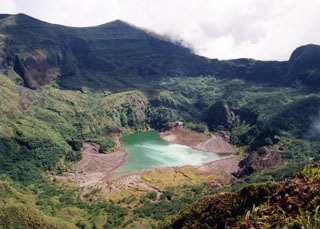Report on Awu (Indonesia) — 16 December-22 December 2015
Smithsonian Institution / US Geological Survey
Weekly Volcanic Activity Report, 16 December-22 December 2015
Managing Editor: Sally Sennert.
Please cite this report as:
Global Volcanism Program, 2015. Report on Awu (Indonesia) (Sennert, S, ed.). Weekly Volcanic Activity Report, 16 December-22 December 2015. Smithsonian Institution and US Geological Survey.
Awu
Indonesia
3.689°N, 125.447°E; summit elev. 1318 m
All times are local (unless otherwise noted)
PVMBG reported that on 24 November the number of shallow volcanic earthquakes at Awu increased significantly from a baseline maximum of 4 per day to 258 events; only seven events were recorded the next day. Seismicity continued to decline during 2-15 December. Fog prevented visual observations of the crater. The Alert Level remained at 2 (on a scale of 1-4); residents and tourists were advised to stay 3 km away from the crater.
Geological Summary. The massive Gunung Awu stratovolcano occupies the northern end of Great Sangihe Island, the largest of the Sangihe arc. Deep valleys that form passageways for lahars dissect the flanks of the volcano, which was constructed within a 4.5-km-wide caldera. Powerful explosive eruptions in 1711, 1812, 1856, 1892, and 1966 produced devastating pyroclastic flows and lahars that caused more than 8000 cumulative fatalities. Awu contained a summit crater lake that was 1 km wide and 172 m deep in 1922, but was largely ejected during the 1966 eruption.
Source: Pusat Vulkanologi dan Mitigasi Bencana Geologi (PVMBG, also known as CVGHM)

